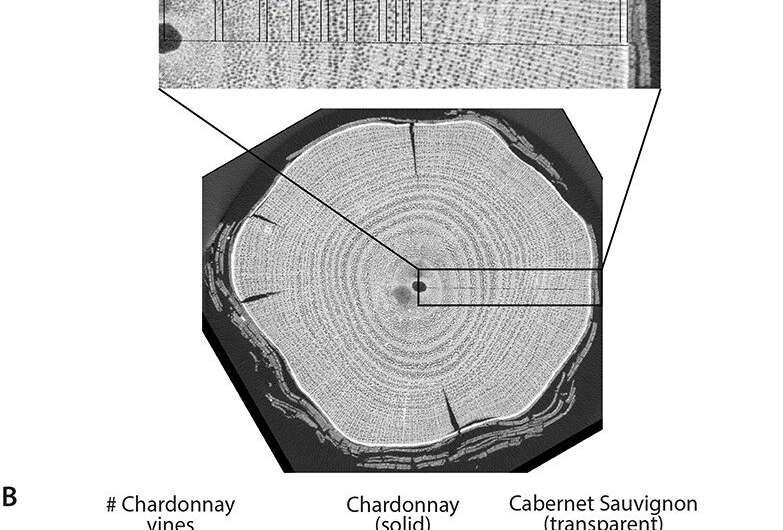This article has been reviewed according to Science X's editorial process and policies. Editors have highlighted the following attributes while ensuring the content's credibility:
fact-checked
peer-reviewed publication
trusted source
proofread
Unveiling the subtle influence of rootstocks on grapevine growth and wine quality: A 30-year X-ray imaging study

Grafting, the union of rootstock and scion to form a single organism with vascular connections, is a critical technique for agriculture, especially in woody perennials like grapevines. Despite the benefits such as disease resistance, drought tolerance, and improved fruit quality, the environmental factors still predominantly dictate grapevine traits.
Wood anatomy and hydraulic conductivity are significantly influenced by grafting, with implications for drought resistance and overall plant health. However, the complexity of interactions between grafted components and their environment is not fully understood. The precise role of grafting in shaping wood anatomy and its subsequent impact on vine physiology and productivity, particularly how rootstock-scion compatibility and alignment affect secondary growth, represents a critical area for future research.
In October 2022, Horticulture Research published a perspective titled "X-ray imaging of 30 year old wine grape wood reveals cumulative impacts of rootstocks on scion secondary growth and Ravaz index."
In this study, X-ray computed tomography was employed to investigate how 15 different rootstocks affect the secondary growth of 30-year-old Chardonnay and Cabernet Sauvignon grapevines.
First, researchers applied a model that incorporated scion and rootstock variables to predict the scion trunk radius. This model revealed that scion accounted for 46.53% of the variation, rootstock for 16.57%, and their interaction for just 2.42%. Additionally, within the same scion type, rootstock significantly altered the scion trunk radius range, with a notable 143% and 129% difference between the widest and narrowest trunk radii conferred by specific rootstocks in Chardonnay and Cabernet Sauvignon respectively.
In addition, the study utilized a negative exponential model to explore how scion and rootstock influence ring width across the scion trunk. Changes in the model parameters (A, B, and k) indicated that A influenced overall ring width, B the early rings' width, and k the rate at which ring width approached the asymptote.
Notably, Cabernet Sauvignon consistently had wider ring widths compared to Chardonnay. The significance of the scion and rootstock on these parameters varied, with rootstock showing a significant effect on the decay parameter k, explaining 22.68% of the variation. The study correlated various traits with ring features, using a large dataset that spanned different years.
The Ravaz index and juice pH were found to be robustly correlated with ring and trunk widths. The Ravaz index, in particular, was negatively correlated with scion trunk radius, suggesting that larger trunks correspond to lower yields relative to pruning weight.
Finally, the study measured physiological traits, including assimilation rate, transpiration rate, and water use efficiency (WUEi), across different rootstocks to determine the effect of scion trunk radius on vine physiology. The findings suggested that vines with wider trunks had higher rates of assimilation and transpiration but decreased water use efficiency. Leaf temperature, however, did not show a significant correlation with scion trunk radius.
In conclusion, this study demonstrates that rootstocks play a critical role in the vine's adaptation to genetic and environmental factors. The ability to modulate vegetative growth and yield through rootstock choice holds the potential for advancing grape cultivation, informing vineyard management practices, and optimizing fruit and wine quality in woody perennial crop species.
More information: Zoë Migicovsky et al, X-ray imaging of 30 year old wine grape wood reveals cumulative impacts of rootstocks on scion secondary growth and Ravaz index, Horticulture Research (2022). DOI: 10.1093/hr/uhac226
Journal information: Horticulture Research
Provided by NanJing Agricultural University


















